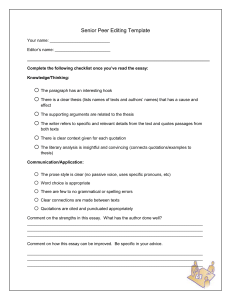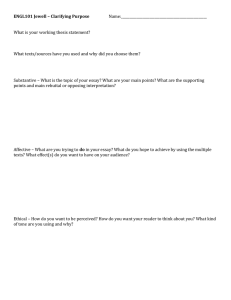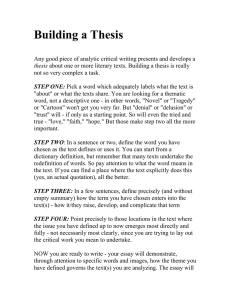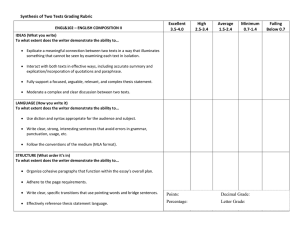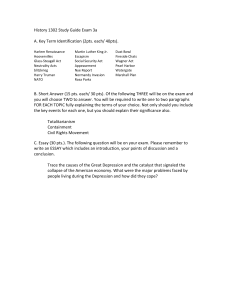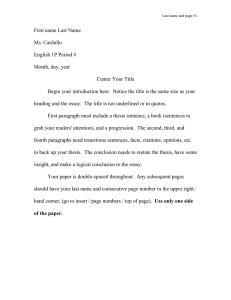E 4—S : W
advertisement
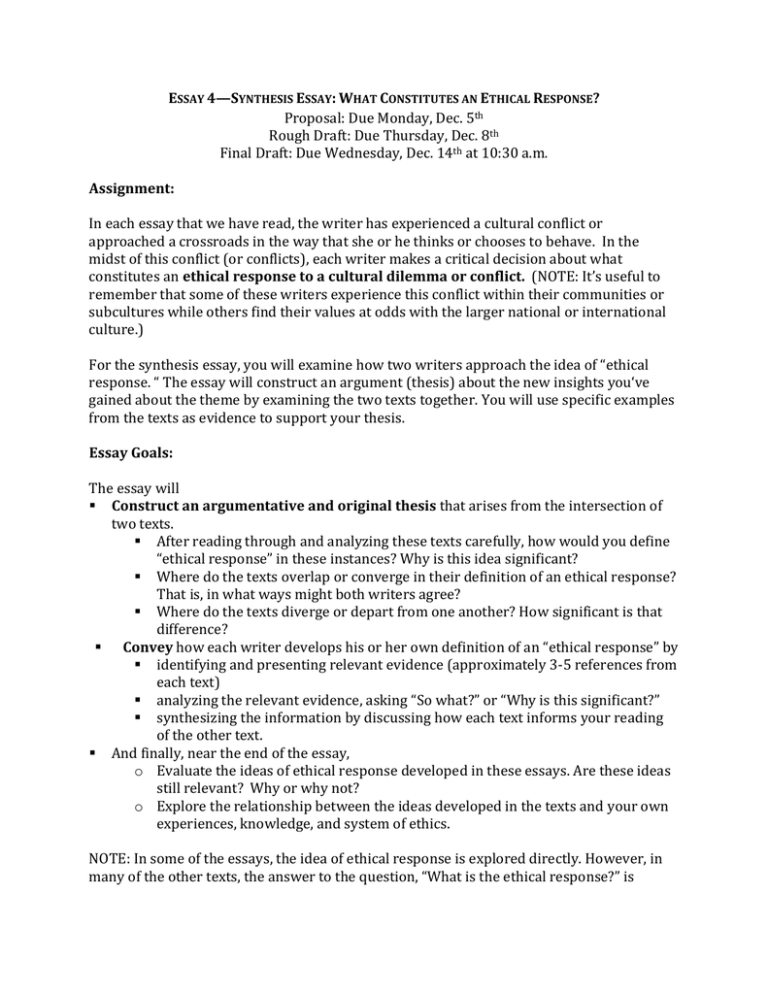
ESSAY 4—SYNTHESIS ESSAY: WHAT CONSTITUTES AN ETHICAL RESPONSE? Proposal: Due Monday, Dec. 5th Rough Draft: Due Thursday, Dec. 8th Final Draft: Due Wednesday, Dec. 14th at 10:30 a.m. Assignment: In each essay that we have read, the writer has experienced a cultural conflict or approached a crossroads in the way that she or he thinks or chooses to behave. In the midst of this conflict (or conflicts), each writer makes a critical decision about what constitutes an ethical response to a cultural dilemma or conflict. (NOTE: It’s useful to remember that some of these writers experience this conflict within their communities or subcultures while others find their values at odds with the larger national or international culture.) For the synthesis essay, you will examine how two writers approach the idea of “ethical response. “ The essay will construct an argument (thesis) about the new insights you‘ve gained about the theme by examining the two texts together. You will use specific examples from the texts as evidence to support your thesis. Essay Goals: The essay will Construct an argumentative and original thesis that arises from the intersection of two texts. After reading through and analyzing these texts carefully, how would you define “ethical response” in these instances? Why is this idea significant? Where do the texts overlap or converge in their definition of an ethical response? That is, in what ways might both writers agree? Where do the texts diverge or depart from one another? How significant is that difference? Convey how each writer develops his or her own definition of an “ethical response” by identifying and presenting relevant evidence (approximately 3-5 references from each text) analyzing the relevant evidence, asking “So what?” or “Why is this significant?” synthesizing the information by discussing how each text informs your reading of the other text. And finally, near the end of the essay, o Evaluate the ideas of ethical response developed in these essays. Are these ideas still relevant? Why or why not? o Explore the relationship between the ideas developed in the texts and your own experiences, knowledge, and system of ethics. NOTE: In some of the essays, the idea of ethical response is explored directly. However, in many of the other texts, the answer to the question, “What is the ethical response?” is implied or stated indirectly. In these texts, you will need to use evidence from the essay to support your interpretation of what the “ethical response” might be. Expectations: The essay should be 4-5 pages, double-spaced, in Times New Roman font with 1” margins. The essay should be formatted in MLA style and include a Works Cited page. Questions to Consider for Freewrites and Responses: We have spent the quarter talking about “revolutions” and the idea of making a fundamental change in yourself and/or your community. What kind of fundamental change is each text calling for? Why is this change so significant? Can this change be read as an ethical imperative? What seem to be the writers’ central values—that is, what do they consider worth fighting for? How might these values be in tension with their own communities or with the larger national and international culture in which the writer lives? According to these texts, is it ever ethical to break the law, go against the opinion of the crowd, or disrupt the usual rules of civility and politeness? Why or why not? What kinds of action do the writers’ urge? Is this form of action or ethical response still relevant today? Why? Possible Texts: Sherman Alexie, “The Joys of Reading and Writing: Superman and Me” Gloria Anzaldua, “How to Tame a Wild Tongue” Fredrick Douglass, “Learning to Read and Write” Barbara Ehrenreich, “Serving in Florida” Martin Luther King, Jr., “Letter from Birmingham Jail;” Langston Hughes, “Salvation” Audre Lorde, “The Fourth of July” Nancy Mairs, “On Being a Cripple” Excellent—4.0-3.5 High—3.4-2.5 Average—2.4-1.9 Minimum—1.8-0 Analysis Provides substantial, specific evidence from both source texts. Thoroughly analyzes material from both sources by answering the "so what?" question for every piece of evidence that she provides. All claims are specific, arguable and supported by evidence from the source texts. Explores the ideas presented in full. 36-40 pts. Provides significant evidence from both texts, but more detailed evidence is needed. Analyzes the evidence from both sources, answering the "so what?" question for most pieces of evidence that she provides. Most claims are specific, arguable and supported by evidence from the source texts Explores most of the ideas presented, but some of the ideas remain underdeveloped. 32-34 pts. Provides some evidence from both texts, but evidence needs to be more specific or presented more clearly. Begins to analyze the sources by answering the "so what?" question for some pieces of evidence, but some significant evidence remains unanalyzed. Some claims are specific, arguable and supported by evidence, but others remain unsupported. Many ideas remain underdeveloped. 28-30 pts. Provides insufficient evidence from one or both texts. The source material is not adequately analyzed; the text fails to answer the "so what?" question for crucial pieces of evidence. Most of the claims are not specific, arguable or supported by evidence. The essay does not adequately develop the ideas presented. 0-26 pts. Points ?? / 40 Comments Thesis and Topic Sentences The thesis statement and topic sentences are specific and arguable, clearly defining a complex relationship between texts and answering the question, “So what?” The essay is driven by and organized around a strong thesis. 36-40 pts. Comments Most versions of the thesis statement and topic sentences are specific and arguable, but they are unclear or under-developed in a few places. The thesis expresses a relationship between the two source texts, but that relationship could be more fully developed. 32-34 pts. The thesis and topic sentences are specific and arguable at some points but unclear at other, or they represent a statement of fact rather than an argument. The thesis begins to express a relationship between the two sources, but the link is unclear or unconvincing. 28-30 pts. The thesis and topic sentences are difficult to identify throughout the paper. The thesis fails to answer the question, “So what?” Topic sentences are misleading or unclear. The thesis does not express a clear relationship between the sources. 0-26 pts. Ideas are organized in a clear and logical fashion in relationship to each other (local, within paragraphs) and to the thesis (the paper as a whole). Includes a vivid, engaging, and informative introduction and an inventive and thorough conclusion. 36-40 pts. Ideas are organized in a clear and logical fashion in relationship to each other (local, within paragraphs) and to the thesis (the paper as a whole). Includes an informative, appropriate introduction and a thorough conclusion. 32-34 pts. Although ideas are generally organized in a logical fashion, some sentences or paragraphs are unorganized or unrelated to the thesis or paragraph. Transitions are often lacking, leaving the reader lost. Includes an adequate intro. and/or conclusion. 28-30 pts. Discernible organization is minimal or nonexistent. Underdeveloped or missing introduction and/or conclusion. Minimal or no transitions between paragraphs. 0-26 pts Style and Mechanics Ideas are expressed in clear, engaging prose. The writer uses specific and vivid language. The sentence lengths and types vary, and word choice is appropriate throughout. Demonstrates attention to audience and purpose. No grammatical, proofreading, or mechanical errors. 36-40 pts. Most of the ideas are expressed in clear, readable prose, but a few sentences are awkward or difficult to understand. The writer uses a variety of sentence types, but some sentences could be more effective. Most word choice is appropriate. Demonstrates attention to audience and purpose. Infrequent grammatical, proofreading, or mechanics errors. (Errors do not disrupt the flow or clarity of the text.) 32-34 pts. Some of the ideas are expressed in clear, readable prose, but there are many sentences that are awkward or difficult to understand. Uses the same sentence type throughout. The relationship to audience or purpose is sometimes unclear. There are some strong sentences, but there are more than 2-4 sentence structure problems. Grammatical, proofreading, and mechanical errors sometimes impede flow or clarity. 28-30 pts. Most of the prose is difficult to read. Does not demonstrate an understanding of audience and purpose. Frequent sentence structure problems. Sentence level, grammatical, and mechanics problems seriously impede the clarity of the text. 0-26 pts. Points ?? / 40 Quotations and citations Comments The paper incorporates some ideas or quotations from both sources, but the sources could be used more fully. Most quotations from both texts are cited correctly. Quotations are incorporated correctly into the text, but some transitions are awkward or unclear. 32-34 pts. The paper incorporates at least one quotation or idea from each source, but more citations/references are needed. Quotations are cited, but some citations are incorrect. At times the relationship between the quotation and the rest of the essay is unclear. 28-30 pts. The paper does not include quotations from one or both of the source. Some quotations are not cited, and they are not well-integrated into the text. 0-26 points pts. Criteria Points ?? / 40 Organization Points ??/40 The paper incorporates substantial ideas and quotations from both textual sources. All quotations from both texts are cited correctly. Quotations are incorporated seamlessly into the text of the essay. 36-40 pts. Points ??/40 Total Points: /200
